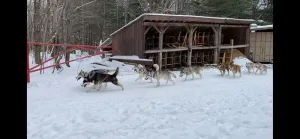(Press-News.org) It’s a place where few living things can survive in the water.
Deep in the world’s largest rainforest, there is a boiling river. Found in eastern central Peru, it is a small tributary that eventually leads to the Amazon River.
Heated by cracks in the Earth’s crust, at its warmest spots, the water can reach 200 degrees Fahrenheit, an inhospitable environment with air temperatures hotter than anywhere else in the Amazon.
But the steamy river, known locally as “Shanay-Timpishka,” which translates as “boiled with the heat of the sun,” also offers an interesting perspective on what may happen to plant and tree communities as climate change pushes temperatures upward. After visiting in 2021, a team of University of Miami biologists recognized that the boiling river could serve as a natural experiment.
“It really provides us a window into the future because the Amazon will get hotter whether we like it or not, so this allows us to understand what increases in temperature will do to the forest composition,” said Riley Fortier, lead author on a study of the site published recently in Global Change Biology, and a graduate student in professor Kenneth Feeley’s Jungle Biology lab. “It can tell us which species will be lost, and what the makeup of the forest might be like in the future.”
The boiling river, a tributary of the Amazon River.
The team returned to Peru in 2022 and mapped the tropical plants and trees found in the area at 70 locations, starting upstream, where temperatures were cooler, down to the hottest part of the boiling river, where air temperatures often exceed 110 degrees Fahrenheit.
By examining forests for about a mile along the sweltering river and monitoring temperatures with onsite sensors, the team found several insights. They saw that plant diversity declined in the hottest parts of the river—with an 11 percent drop in tree diversity per each degree of warming—and that only plants suited for very warm tropical climates are able to thrive near the boiling river. Their results predict how tropical rainforests could look in the future Amazon as global warming continues.
“Overall, the tree community is less diverse, so we see fewer species in hotter spots,” Fortier said. “And forest composition was also more homogenous in the warmest locations, whereas in cooler forest plots, there was more plant diversity.”
One thing that surprised Fortier was how quickly the vegetation changed along the river.
“We saw a very directional change in composition, where the hottest part of the forest along the river had a greater representation of species that grow in hotter areas of the Amazon,” Fortier added. “Then, there was a drastic change in species as you moved away from the hottest part of the river. Usually, you wouldn’t see such a clear change in the species composition over such a short distance.”
For example, Fortier and Feeley saw that the hotter areas around the boiling river were drier and had more vines and scrubby vegetation. The trees were also smaller and less diverse, similar to a transition zone between a forest and a savanna ecosystem, but all within less than a mile of lush, green jungle.
“Over the course of dozens of miles, you might expect to see dramatic changes like that, but in the small sampling area that we had, you typically wouldn’t see such a clear change in composition,” Fortier added.
From left: A research collaborator along with biology professor Ken Feeley, and graduate students Alyssa Kullberg and Riley Fortier.
Feeley’s lab will continue its research of the boiling river, since it is such a unique place that could portend much about our natural world.
“You can’t heat a whole forest, at least not artificially, which is one of the coolest aspects of the boiling river,” Fortier added. “It’s a useful system because we can isolate temperature as having such an important effect on an entire plant community. At the boiling river, the rainfall, soil, and humidity are constant, but what we see is that as global warming happens, everything will change.”
END
A window into the future of Amazonia
New research from a team of tropical biologists forecasts some of the changes that may occur in the Amazon rainforest as temperatures rise due to climate change
2025-01-29
ELSE PRESS RELEASES FROM THIS DATE:
3D models of uveal melanoma offer hope for improved treatments
2025-01-29
ROCHESTER, Minnesota — Mayo Clinic researchers have developed organoid models to study uveal melanoma, one of the most common types of eye cancer in adults. Their goal is to use these models to better understand how this disease works and develop treatments for unmet patient needs.
Organoids are 3D models grown from patient tissue that accurately reflect a patient's unique genetic and biological characteristics, also known as "avatars." When derived from a patient's cancer tumor, an organoid will behave and respond to treatments outside the body in a lab (in vitro) just like the original tumor would inside the body (in vivo).
In 50% of patients, ...
Chemical looping turns environmental waste into fuel
2025-01-29
COLUMBUS, Ohio – Turning environmental waste into useful chemical resources could solve many of the inevitable challenges of our growing amounts of discarded plastics, paper and food waste, according to new research.
In a significant breakthrough, researchers from The Ohio State University have developed a technology to transform materials like plastics and agricultural waste into syngas, a substance most often used to create chemicals and fuels like formaldehyde and methanol.
Using simulations to test how well the system could break down waste, scientists found that their approach, called ...
Working dogs take a day to adjust to Daylight Savings Time, but pets are more flexible
2025-01-29
Working dogs take a day to adjust to the change in routine caused by Daylight Savings Time, whereas pet dogs and their owners seem to be unaffected, according to a study publishing January 29, 2025 in the open-access journal PLOS One by Lavania Nagendran, Ming Fei Li and colleagues at the University of Toronto, Canada.
Daylight Savings Time (DST) is used by many countries to maintain the alignment between daylight hours and human activity patterns, by setting clocks forward one hour in the spring and back one hour in the autumn. Previous research has shown that DST can disrupt ...
Reviews of movies with female- versus male-dominated casts found to contain more sexist language
2025-01-29
In a new linguistic analysis, reviews of movies with female-dominated casts were found to have significantly higher levels of sexism than reviews of movies with male-dominated casts. Jad Doughman and Wael Khreich of the American University of Beirut, Lebanon, present these findings in the open-access journal PLOS One, on January 29, 2025.
Prior research suggests that negative movie reviews can affect actors’ finances, career paths, and mental well-being, while also influencing the broader media landscape. However, studies of gender bias in reviews have traditionally relied on movie ratings or box-office ...
Women exercising in gyms often face barriers including body image and harassment
2025-01-29
When exercising in gyms, women face barriers across various domains, including physical appearance and body image, gym attire, the physical gym environment, and interactions with others, according to a study published January 29, 2025, in the open-access journal PLOS One by Emma Cowley from the SHE Research Centre, TUS, Ireland, and Jekaterina Schneider from the University of the West of England, U.K.
Exercise significantly improves physical, mental, and psychosocial health. Recent research indicates that women who engage in regular exercise experience greater health benefits than men, including lower incidence of all-cause mortality and reduced ...
SNU researchers apply the principles of mantis shrimp and fleas to create soft robots with powerful movements
2025-01-29
Seoul National University College of Engineering announced that a research team led by Professor Kyu-Jin Cho (Director of the Soft Robotics Research Center) from the Department of Mechanical Engineering took inspiration from principles found in nature and developed the "Hyperelastic Torque Reversal Mechanism (HeTRM)," which enables robots made from rubber-like soft materials to perform rapid and powerful movements. This study was published in the prestigious international journal Science Robotics on January 29.
The mantis shrimp delivers a punch ...
Quantum-inspired computing drives major advance in simulating turbulence
2025-01-29
UNDER EMBARGO UNTIL 19:00 GMT / 14:00 ET, WEDNESDAY 29 JANUARY 2025
Quantum-inspired computing drives major advance in simulating turbulence
Researchers at the University of Oxford have pioneered a new approach to simulate turbulent systems, based on probabilities. The findings have been published today (29 January) in the journal Science Advances.
Predicting the dynamics of turbulent fluid flows has long been a central goal for scientists and engineers. Yet, even with modern computing technology, direct and accurate simulation of all but the simplest turbulent flows remains impossible.
This is due to turbulence being ...
New microscopy technique reveals dynamic Escherichia coli membrane stiffness
2025-01-29
Light and electron microscopy have distinct limitations. Light microscopy makes it difficult to resolve smaller and smaller features, and electron microscopy resolves small structures, but samples must be meticulously prepared, killing any live specimens.
Atomic force microscopy (AFM) is a technique originally developed to assess the physical and mechanical properties of materials at extremely high resolutions, but the imaging speeds aren’t fast enough (e.g. several minutes per frame) to capture relevant data for living biological samples. In contrast, another method, high-speed AFM (HS-AFM), is fast but cannot measure mechanical properties. Understanding ...
Bad hair bears! Greasy hair gives polar bears fur with anti-icing properties
2025-01-29
An international team of scientists has discovered the anti-icing secret of polar bear fur – something that allows one of the planet’s most iconic animals to survive and thrive in one of its most punishing climates. That secret? Greasy hair.
After some polar sleuthing, which involved scrutiny of hair collected from six polar bears in the wild, the scientists homed in on the hair “sebum” (or grease) as the all-important protectant. This sebum, which is made up of cholesterol, diacylglycerols, and fatty acids, makes it very hard for ice to attach to their fur.
While this finding ...
Materials can remember a sequence of events in an unexpected way
2025-01-29
UNIVERSITY PARK, Pa. — Many materials store information about what has happened to them in a sort of material memory, like wrinkles on a once crumpled piece of paper. Now, a team led by Penn State physicists has uncovered how, under specific conditions, some materials seemingly violate underlying mathematics to store memories about the sequence of previous deformations. According to the researchers, the method, described in a paper appearing today (Jan. 29) in the journal Science Advances, could inspire new ways to store information in ...
LAST 30 PRESS RELEASES:
Jeonbuk National University study shows positive parenting can protect adolescents against self-harm
Surface-engineered ZnO nanocrystals to tackle perfluoroalkyl substance contamination
This new understanding of T cell receptors may improve cancer immunotherapies
A new fossil face sheds light on early migrations of ancient human ancestor
A new immunotherapy approach could work for many types of cancer
A new way to diagnose deadly lung infections and save lives
40 percent of MRI signals do not correspond to actual brain activity
How brain-inspired algorithms could drive down AI energy costs
Gum disease may be linked to plaque buildup in arteries, higher risk of major CVD events
Contrails are a major driver of aviation’s climate impact
Structure of dopamine-releasing neurons relates to the type of circuits they form for smell-processing
Reducing social isolation protects the brain in later life
Keeping the heart healthy increases longevity even after cancer
Young adults commonly mix cannabis with nicotine and tobacco
Comprehensive review illuminates tau protein's dual nature in brain health, disease, and emerging psychiatric connections
Book prepares K-12 leaders for the next public health crisis
Storms in the Southern Ocean mitigates global warming
Seals on the move: Research reveals key data for offshore development and international ecology
Sports injuries sustained during your period might be more severe
World's first successful 2 Tbit/s free-space optical communication using small optical terminals mountable on satellites and HAPS
Can intimate relationships affect your heart? New study says ‘yes’
Scalable and healable gradient textiles for multi‑scenario radiative cooling via bicomponent blow spinning
Research shows informed traders never let a good climate crisis go to waste
Intelligent XGBoost framework enhances asphalt pavement skid resistance assessment
Dual-function biomaterials for postoperative osteosarcoma: Tumor suppression and bone regeneration
New framework reveals where transport emissions concentrate in Singapore
NTP-enhanced lattice oxygen activation in Ce-Co catalysts for low-temperature soot combustion
Synergistic interface engineering in Cu-Zn-Ce catalysts for efficient CO2 hydrogenation to methanol
COVID-19 leaves a lasting mark on the human brain
Scientists use ultrasound to soften and treat cancer tumors without damaging healthy tissue
[Press-News.org] A window into the future of AmazoniaNew research from a team of tropical biologists forecasts some of the changes that may occur in the Amazon rainforest as temperatures rise due to climate change






